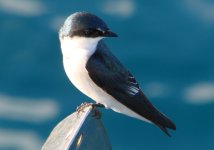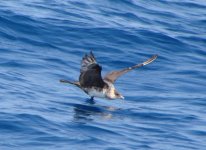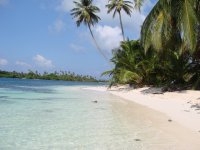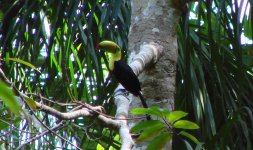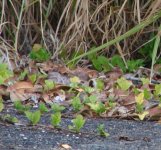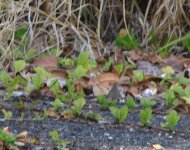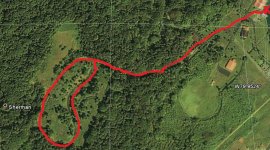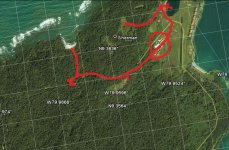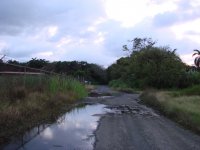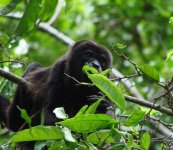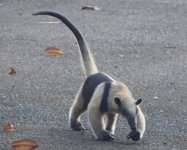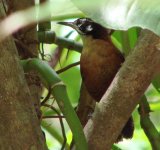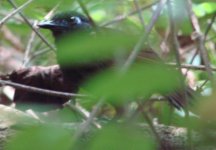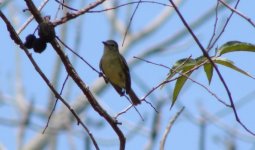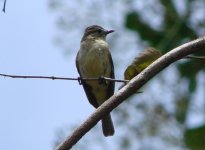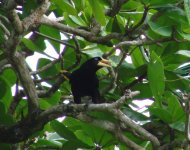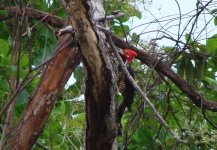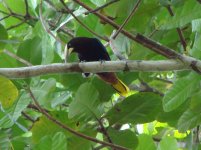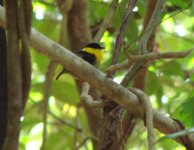SueO
Well-known member
Peregrine in Panama
On October 31, 2000, we began our attempt to sail around the world aboard our 43 foot sailboat, Peregrine. It’s been a long nine years and I found myself wanting to really push this last stretch and get home as soon as possible. We only have to get through the canal and go north to Newport Beach, California (only!). I thought how ironic that just as we came upon some of the best birding areas of the world, I was too burnt out to want to linger and enjoy. Since making landfall in Panama I have gotten a second wind. I can easily linger here.
We are now safely at dock on the Caribbean side of the canal. We have very nice live-ashore amenities and the rain forest is our backyard. I saw my first wild Toucan yesterday; a Keel-billed Toucan—gorgeous!
Before arriving here, we made several stops in the Kuna Yala/San Blas Islands and I had some enjoyable days birding an island in the Holandes group. We spent some time in the Linton Island anchorage (about eight miles east of Portobello). I went ashore nearly every day there and collected quite a list.
I have run into a few snags, but overall I have done much better than I thought I would in the identification area. Most of the birds I’ve seen so far are quite distinctive and that makes ID fairly easy. I don’t know how many birds, especially flycatchers, I’ve missed, but relatively few and I am not frustrated yet. However, there are some birds I’m struggling with and would like to have some discussion about them. I have done some searching on the net, but still have questions. I will post them on the ID forum even though some of the images I got are really bad.
I’ve had a few surprises. I found a bird yesterday that confused me. I went through my huge Panama book and couldn’t find it. I kept thinking I knew the bird. My mind finally came around to buntings and I identified it as an Indigo Bunting. I’ve only seen one once before (in Arkansas) and it was in breeding plumage, so the non-breeding plumage threw me. The bird is not listed in the Panama book.
Also yesterday, I found a little bird that screamed “pipit” as soon as my bins landed on it. It doesn’t seem to fit any pipits though, and after reading a bit, I thought my bird must be a Northern Water-thrush. It flicked its tail and bobbed a bit like a Spotted Sandpiper (mentioned in the description), but it did not have a boldly streaked breast. Do the streaks ever fade? I only saw it for seconds—and not well. I have two horrible and distant shots because after I flushed it, I got it in my bins but it was distant and I wanted to try to creep up and get a better view. I figured I should try to get a few long distance photos before I moved in case it flew. It flew as soon as I had taken two steps, and I lost it. I will go back this evening and try to find it again.
I hope to have some photos and material on my blog in a few days. I have so much to write about, birding and otherwise that I am overwhelmed (and I would rather be out in the forest than typing). It’s going to take time to get organized. I haven’t even updated my electronic life list yet. It’s awful to have so many lifers each day that I can’t even get them listed . I LOVE this place!
. I LOVE this place!
Here is my Panama list so far:
American Pygmy Kingfisher #746
Bananaquit (Coereba flaveola Mexicana) #715
Barred Antshrike #736
Belted Kingfisher
Black Vulture
Black-bellied (Grey) Plover
Black-crowned Tityra #714
Blue-black Grassquit #713
Blue-chested Hummingbird #731
Blue-gray Tanager #699
Brown Pelican
Buff-breasted Wren #724
Buff-throated Woodcreeper (confirm—eyebrow not mentioned in book)
Cattle Egret
Clay-colored Thrush #741
Common Black Hawk #705
Common Tody-Flycatcher #739
Crested Guan #710
Crested Oropendola #742
Crimson-backed Tanager #718
Golden –hooded Tanager #726
Gray-breasted Martin #704
Great Blue Heron
Great Egret
Great Kiskadee #725
Greater Ani #730
Great-tailed Grackle
Green Heron
Green Kingfisher #732
House Wren (Troglodytes aedon inquietus) #711
Indigo Bunting
Keel-billed Toucan #747
Laughing Gull
Lesser Kiskadee #734
Lesser Seed Finch #729
Little Blue Heron
Magnificent Frigatebird
Mangrove Swallow #703
Neotropic Cormorant
Northern Scrub Flycatcher ?? (further research needed—not supposed to be in the San Blas? Could the Southern from the West Indies be here??)
Orange-chinned Parakeet #716
Osprey
Palm Tanager #728
Plain-colored Tanager #720
Pomarine Jaeger #697
Red and Green Macaw #722
Red-crowned Woodpecker #712
Red-legged Honeyeater #737
Rose-breasted Grosbeak #744
Royal Tern
Ruddy Ground Dove #708
Ruddy Turnstones
Rufous-breasted Hermit #723
Rusty-margined Flycatcher #748
Sapphire-throated Hummingbird #698
Smooth-billed Ani
Snowy Egret
Southern Lapwing #721
Southern Rough-winged Swallow #733
Spot-crowned Barbet #740
Spotted Sandpiper
Squirrel Cuckoo #717
Thick-billed Euphonia #727
Tropical Kingbird #706
Tropical Mockingbird
Turkey Vulture
Variable Seedeater #707
White-crowned Pigeon #701
White-tipped Dove
Willet
Yellow Mangrove Warbler #700
Yellow Warbler
Yellow-bellied Eleania (Eleania flavogaster pallidorsalis) #719
Yellow-crowned Euphonia #735
Yellow-crowned Night Heron
Yellow-faced Grassquit #709
Yellow-headed Caracara #702
Yellow-tailed Oriole #743
Streaked Flycatcher (Myiodynastes maculates insolens)???(confirm—bill seems small)
The Mangrove Swallows hang out on the boat, almost pets.
Sue
On October 31, 2000, we began our attempt to sail around the world aboard our 43 foot sailboat, Peregrine. It’s been a long nine years and I found myself wanting to really push this last stretch and get home as soon as possible. We only have to get through the canal and go north to Newport Beach, California (only!). I thought how ironic that just as we came upon some of the best birding areas of the world, I was too burnt out to want to linger and enjoy. Since making landfall in Panama I have gotten a second wind. I can easily linger here.
We are now safely at dock on the Caribbean side of the canal. We have very nice live-ashore amenities and the rain forest is our backyard. I saw my first wild Toucan yesterday; a Keel-billed Toucan—gorgeous!
Before arriving here, we made several stops in the Kuna Yala/San Blas Islands and I had some enjoyable days birding an island in the Holandes group. We spent some time in the Linton Island anchorage (about eight miles east of Portobello). I went ashore nearly every day there and collected quite a list.
I have run into a few snags, but overall I have done much better than I thought I would in the identification area. Most of the birds I’ve seen so far are quite distinctive and that makes ID fairly easy. I don’t know how many birds, especially flycatchers, I’ve missed, but relatively few and I am not frustrated yet. However, there are some birds I’m struggling with and would like to have some discussion about them. I have done some searching on the net, but still have questions. I will post them on the ID forum even though some of the images I got are really bad.
I’ve had a few surprises. I found a bird yesterday that confused me. I went through my huge Panama book and couldn’t find it. I kept thinking I knew the bird. My mind finally came around to buntings and I identified it as an Indigo Bunting. I’ve only seen one once before (in Arkansas) and it was in breeding plumage, so the non-breeding plumage threw me. The bird is not listed in the Panama book.
Also yesterday, I found a little bird that screamed “pipit” as soon as my bins landed on it. It doesn’t seem to fit any pipits though, and after reading a bit, I thought my bird must be a Northern Water-thrush. It flicked its tail and bobbed a bit like a Spotted Sandpiper (mentioned in the description), but it did not have a boldly streaked breast. Do the streaks ever fade? I only saw it for seconds—and not well. I have two horrible and distant shots because after I flushed it, I got it in my bins but it was distant and I wanted to try to creep up and get a better view. I figured I should try to get a few long distance photos before I moved in case it flew. It flew as soon as I had taken two steps, and I lost it. I will go back this evening and try to find it again.
I hope to have some photos and material on my blog in a few days. I have so much to write about, birding and otherwise that I am overwhelmed (and I would rather be out in the forest than typing). It’s going to take time to get organized. I haven’t even updated my electronic life list yet. It’s awful to have so many lifers each day that I can’t even get them listed
Here is my Panama list so far:
American Pygmy Kingfisher #746
Bananaquit (Coereba flaveola Mexicana) #715
Barred Antshrike #736
Belted Kingfisher
Black Vulture
Black-bellied (Grey) Plover
Black-crowned Tityra #714
Blue-black Grassquit #713
Blue-chested Hummingbird #731
Blue-gray Tanager #699
Brown Pelican
Buff-breasted Wren #724
Buff-throated Woodcreeper (confirm—eyebrow not mentioned in book)
Cattle Egret
Clay-colored Thrush #741
Common Black Hawk #705
Common Tody-Flycatcher #739
Crested Guan #710
Crested Oropendola #742
Crimson-backed Tanager #718
Golden –hooded Tanager #726
Gray-breasted Martin #704
Great Blue Heron
Great Egret
Great Kiskadee #725
Greater Ani #730
Great-tailed Grackle
Green Heron
Green Kingfisher #732
House Wren (Troglodytes aedon inquietus) #711
Indigo Bunting
Keel-billed Toucan #747
Laughing Gull
Lesser Kiskadee #734
Lesser Seed Finch #729
Little Blue Heron
Magnificent Frigatebird
Mangrove Swallow #703
Neotropic Cormorant
Northern Scrub Flycatcher ?? (further research needed—not supposed to be in the San Blas? Could the Southern from the West Indies be here??)
Orange-chinned Parakeet #716
Osprey
Palm Tanager #728
Plain-colored Tanager #720
Pomarine Jaeger #697
Red and Green Macaw #722
Red-crowned Woodpecker #712
Red-legged Honeyeater #737
Rose-breasted Grosbeak #744
Royal Tern
Ruddy Ground Dove #708
Ruddy Turnstones
Rufous-breasted Hermit #723
Rusty-margined Flycatcher #748
Sapphire-throated Hummingbird #698
Smooth-billed Ani
Snowy Egret
Southern Lapwing #721
Southern Rough-winged Swallow #733
Spot-crowned Barbet #740
Spotted Sandpiper
Squirrel Cuckoo #717
Thick-billed Euphonia #727
Tropical Kingbird #706
Tropical Mockingbird
Turkey Vulture
Variable Seedeater #707
White-crowned Pigeon #701
White-tipped Dove
Willet
Yellow Mangrove Warbler #700
Yellow Warbler
Yellow-bellied Eleania (Eleania flavogaster pallidorsalis) #719
Yellow-crowned Euphonia #735
Yellow-crowned Night Heron
Yellow-faced Grassquit #709
Yellow-headed Caracara #702
Yellow-tailed Oriole #743
Streaked Flycatcher (Myiodynastes maculates insolens)???(confirm—bill seems small)
The Mangrove Swallows hang out on the boat, almost pets.
Sue




